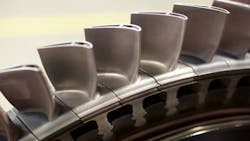Improving 3D Printing Accuracy with Process Simulation
Over the past two years, Siemens has put 3D printing (aka additive manufacturing, or AM) at the forefront of its digitalization strategy along with its Mindsphere platform, enterprise data management and Industrial Internet of Things (IIoT) app development. In particular, I’m referencing Siemens’ extension of its partnership with HP by connecting Siemens NX and SolidEdge software with HP’s Jet Fusion 3D 300/500 series printers, and also Siemens' work with Hackrod to demonstrate how digitalization can bring custom engineering and manufacturing to the masses via 3D printing.
Adding to this, Siemens has just announced the upcoming release of a new Additive Manufacturing (AM) Process Simulation software for predicting distortion during 3D printing. Based on the company’s Simcenter portfolio, the new software uses a digital twin to simulate the build process prior to printing in order to anticipate distortion within the printing process and automatically correct the geometry to compensate for these distortions.
"This simulation is necessary for achieving the efficiencies required of a fully industrialized additive manufacturing process,” according to Siemens' announcement. “The AM Process Simulation solution offers the ability to iterate on a solution between the design and build tray setup steps of the workflow, and the simulation step. The simulation data created feeds into the digital thread of information, which informs each step of the printing process. This digital backbone enables the system to develop pre-compensated models and feed those back into the model design and manufacturing processes without additional data translation.”
Siemens notes that the capabilities provided by this new software are critical to the additive manufacturing of metal parts because the method used to fuse the layers typically involves heat. As the layers build up, the residual heat can cause parts to warp inside the printer, which can lead to various problems from structural issues within the part itself to print stoppage. Simulation of the printing process can help to alleviate many of these problems, the company notes.
"Using the Simcenter 3D AM Process Simulation solution at toolcraft will allow us to complete our additive manufacturing workflow," says Christoph Hauck, managing director of MBFZ toolcraft, a provider of components created by metal laser melting. "Through real-world testing, we have gained confidence that the Siemens AM Process Simulation solution will assist us in ensuring quality output from our print process.”
The AM Process Simulation software is expected to be available in January 2019 as part of the latest NX and Simcenter 3D software releases. For more information, visit: www.siemens.com/plm/additivemanufacturing.

